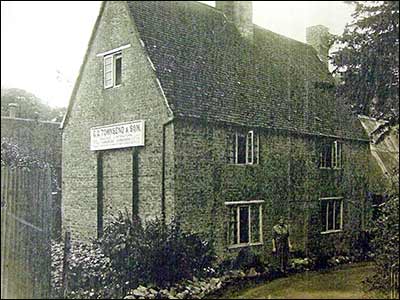 |
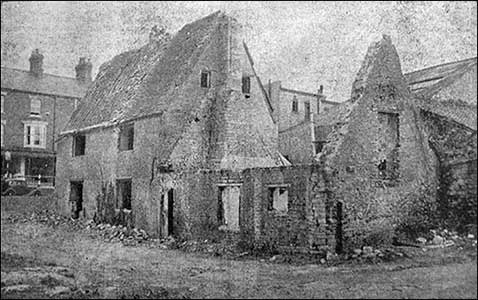 |
Rushden Echo and Argus, 4th June 1954
Another bit of old Rushden is on the way to oblivion. These ancient premises in High Street South, (owned by Townsends (Garages) Ltd.),
once used as a school, have been prepared for demolition and await the arrival of a bulldozer to complete the job.
|
| Rushden Echo & Argus, 13th August 1954 |
| Part of old Rushden that will soon be disappearing are these houses in Little Street, which the Urban Council has scheduled for clearance. Other houses in Beaconsfield Place, Duck Street, Factory Place and High Street South are also to be pulled down. Rushden Urban Council Housing Committee is confident that the necessary re-housing can be provided during next year. Where suitable, the site will be re-developed. |
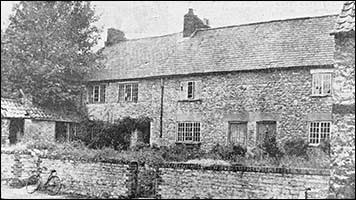 |
Rushden Echo & Argus, 11th November 1954
It’s Goodbye to All This
It’s goodbye to some familiar old cottages in Little Street, Rushden.
The demolitionists are busy in this southern corner of the town, and the stepping-up of clearance work in the locality was agreed to by the Urban Council on Wednesday.
|
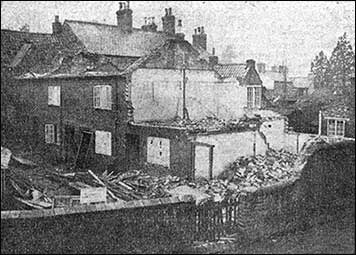 |
The Rushden Echo and Argus, 25th February 1955
Rushden’s first official clearance of old property in the Little Street area has yet to begin, but in the same district odd buildings are now being removed by the owners. The demolitions pictured lie between Little Street and Bedford Road (in the foreground). The old Baptist “Top Meeting” is seen at the rear.
|
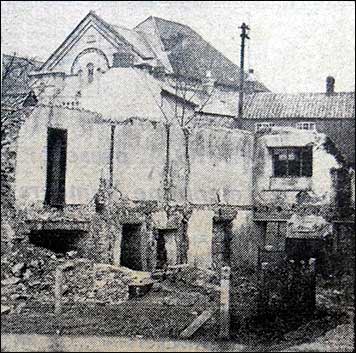 |
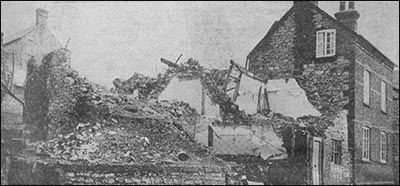 |
Rushden Echo & Argus, 6th January 1956
More demolition work has started in Little Street, this time on a site where the council proposes to develop a housing estate for old people, between Little Street and Park Road.
|
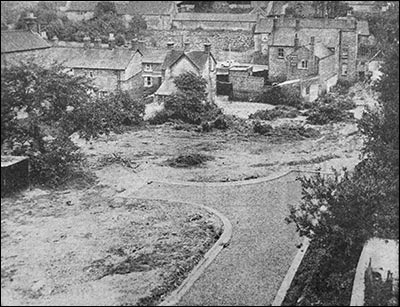 |
Rushden Echo & Argus, 28th September 1956
There will soon be new homes for old in this southerly portion of Rushden.
Some of the town’s oldest cottage properties have been cleared on both sides of Little Street, and the site sloping down from Park Road has been taken over by the Urban Council with a view to the erection of bungalows for old people. Already a miniature approach road has been prepared.
Cherry Orchard bungalows
|
| The Rushden Echo and Argus, 11th September 1953 |
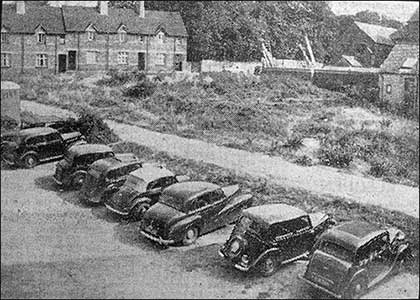 |
| Note: This picture shows a row of cottages in Rectory Road, in 1953 when the car park was being established. See article below for the demolition of the cottages in 1956. |
|
Parking facilities on this site off Rectory Road are to be doubled, thanks to the enterprise of Rushden Co-operative Society, who own the land and will rent it to the Urban Council after putting it in order.
|
|
Rushden Echo & Argus, 20th January 1956, transcribed by Jim Hollis
Now for a New ‘Backway’
As the last inches of brickwork sway and totter, the Rectory Road demolitions at Rushden work up to a climax of interest. It has been an ordinary plodding job – just a one-man job for some of the time – but to me, brought up as a lad on the “Backway” legend, nothing yet planned in the realm of local topography could have greater claim to attention.
|
|
|
After many years of “inching” the widening of Rectory Road, will soon be complete - at long last the bottle neck near the Rectory and opposite the Co-operative car park is being cleared. A row of old houses which jutted out to leave only a narrow strip of roadway is being demolished. When road staff have done their work, it will be a wide road parallel to High Street for general development.
|
It was said at last week’s meeting of the urban council that when the demolitions were complete the town’s general traffic arrangements would be considered. That in itself is a big reason for breathing deeply as the bottleneck disappears – though a great depth of breath will be inhaled before those arrangements work decently. There is also the effect on the landscape and the impetus that will be given to the whole idea of developing an important road parallel with High Street.
It was just after the First World War that Rushden council heard the main spate of optimistic speeches about the future of the “Backway.” In those days the clearance of a few obstacles seemed capable of solving every traffic problem. Traffic, however, was not then the main consideration; there was a wider dream of developing the shopping area and making the town more presentable.
Subsequent nibbles at the old landscape have shown how right was the policy, and the completion of a stage in that policy should but freshen the urge to achieve something new and revolutionary in the heart of Rushden.
Because of wars and the constant lag in all kinds of accommodation, the evolution of Rectory Road has been painfully slow. It may soon be possible to go forward in a big way, and even the stultifying railway need not, according to the latest theories, be looked upon as an obstacle that will be there forever.
|
|
|
Rushden Echo & Argus, 14th Sept 1956
|
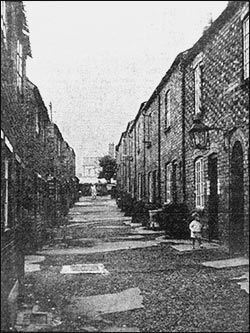 |
|
At the Council meeting reported in the newspaper on 14th September 1956:-
"It was decided to schedule Nos. 1 to 21 South Terrace as a clearance area."
|
see also 1910 valuation
|
|
Duck Street 1956 - 1958
|
Rushden Echo & Argus, 28th Dec 1956
PETROL or no petrol, Rushden will soon be catching up with its car-parking problem, and this area off Duck Street, where the bulldozer has recently been busy, will soon be available for motorists.
|
|
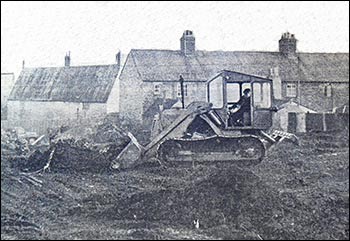 |
Rushden Echo & Argus, 5th April 1957
With big changes afoot in Duck Street, Rushden, old property in this low-lying quarter is rapidly disappearing.
This group, incorporating what was once the unofficial tuck-shop for Alfred Street School, is now in process of demolition, and the site will form part of a new car park.
|
|
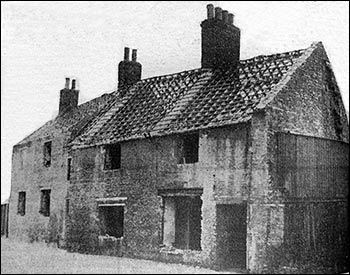 |
The Rushden Echo and Argus, 28th June 1957
Rushden High Street is most emphatically a built-up area yet, right in the middle, this gaping void can be seen today. Two old shops were demolished last week and the site is being prepared for new premises, which will be placed farther from the carriageway.
|
|
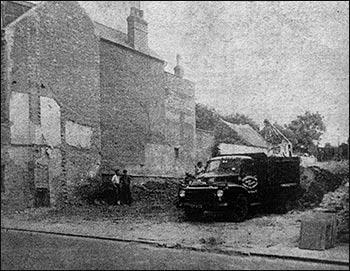 |
The Rushden Echo and Argus, 30th August 1957
Rushden will get a car park, and another approach to the swimming bath, when this site adjacent to Duck Street is cleared. Workmen were this week demolishing the 85-year-old factory occupied for many years by Sanders Ltd., curriers, although some buildings nearby are to be retained there will be enough space for between 40 and 50 cars. The factory was originally built against three old low-roomed cottages, but two of the cottages—relics of village days—have long since disappeared.
|
|
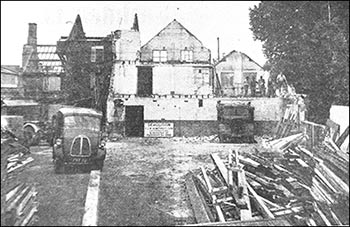 |
|
Two pictures of the demolition in Duck Street
|
Rushden Echo & Argus, 21st Feb 1958
A transformation is coming about in Pung's Lane, Rushden—the narrow branch of Duck Street which climbs to an uneasy junction with High Street.
Purchases of land over the past few years have given the Urban Council scope for a much-needed improvement.
An ample road, with footpaths on either side, will succeed the narrow metalled channel seen on the right. Ground on the left, with an adjoining area not included in the picture, will ultimately be developed as a car park.
|
|
|
|
|
|
And the same area in May 1958
|
|
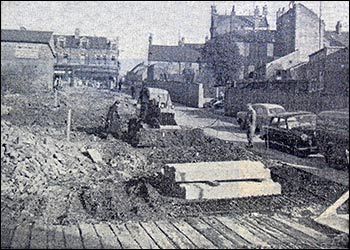 |
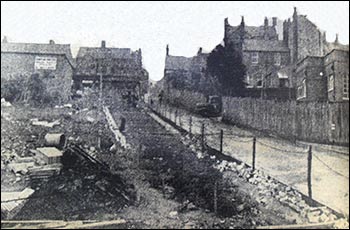 |
The Rushden Echo and Argus, 1st August, 1958
Two more groups of housing property, both brick-built, have incurred the disfavour of the Rushden health authorities and are now listed as clearance areas. The eventual disappearance of Kilburn Place, below right, will leave a gap on the western side of Higham Road – but only temporarily, because the Urban Council favours redevelopment of the site. Woburn Place, below left, stretching from Rectory Road towards High Street, is one of a series of “rows” which have branched out from Rushden’s old “Backway.”
|
|
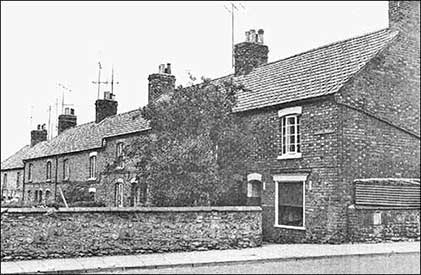 |
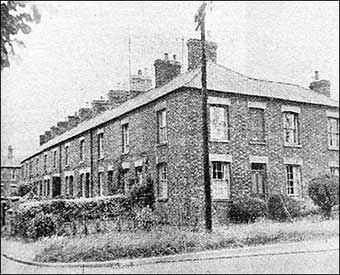 |
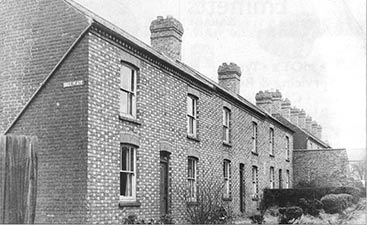 |
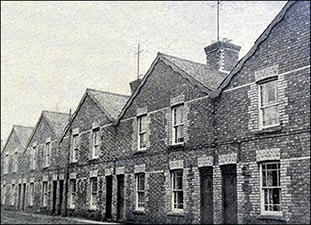 |
|
Dell Place
|
Sussex Place
|
Rushden Echo, 21st February 1958
These houses (right) and those on the opposite side of Sussex Place, Rushden, began their existence in a private street and will finish it on the same plane, for they are to be cleared by order of the Urban Council, which has never adopted the little street as a public thoroughfare. Tucked away to the east of Higham Road, they present an orderly front elevation which gives no clue to the reasons why they have been condemned. Dell Place (left) off Park Road, is also for clearance. It is so secluded that the general public will hardly notice its disappearance. |
|
| The Rushden Echo and Argus, 30th October 1959, transcribed by Jim Hollis
Rushden Hotel under demolition hammer
Demolition work at the Waverley Hotel, Rushden, has unfolded the story of the days when it played a major part in the life of the town.
The company running the Waverley Hotel was formed by a local band of temperance zealots in the days when drunkenness was rife in Rushden, as in many other newly established communities.
For most of its years it has been known as the Coffee Tavern, although for a long time it has been known by the other title, the Waverley Hotel.
Special Place
The hall at the rear has occupied a very special place in Rushden’s history. For many years it was the only sizeable hall available for fetes, bazaars and entertainments in the town. Before the cinematograph was established the Public Hall presented the local public with all that was available in the way of melodrama, by touring companies, spectacular novelties such as Myriorama, amateur plays and operatic performances, minstrel troupes and good class concerts.
Many hectic political meetings were held there, when Liberals and Tories had the field to themselves. Many of the present generation can remember the hurly-burly of meetings addressed by Mr. (later Sir) Francis Channing, for several years the Liberal Member for East Northamptonshire, and Sir Arthur de Capell Brooke, his Conservative opponent.
After the First World War the public hall became a billiard hall until, a few years ago, the Waverley Hotel directors modernised its interior and made possible its use for dinners, dances and similar events.
Quick Work
The hotel and hall closed in the spring and will be a supermarket. Demolition began last week and is expected to be completed by November 15.
The empty shell shows the original purpose of the hall more clearly. Passers by having a last look have noticed signs such as that which marked the old stage entrance, which have never been obvious before.
A new asset will be presented to Rushden when the supermarket is opened and Coffee Tavern Lane will be widened – but a well-known part of the town will be gone.
|
The Rushden Echo and Argus, 13th November 1959, transcribed by Gill Hollis
Hotel demolition recalls fight for temperance
The demolition work being undertaken at the Waverley Hotel, Rushden has naturally been of great interest to Rushden Temperance Society, for the hotel was originally a temperance establishment.
Recalling the days when the building lived up to the “temperance hotel” description which it has always borne, the society’s officials were prompted to look up their old records. They found in their files a picture of a much different Rushden during the hotel’s first days.
In his annual report, given on January 10, 1882, Mr. John Claridge (secretary from 1874-1905) said: “We cannot conclude without referring with satisfaction to the completion of the commodious and handsome Coffee Tavern and Hall to be opened shortly. This building shows to the public that there is a strong temperance element which is doing something to stem the torrent of drunkenness that exists in Rushden.”
The opening was on February 16, 1882, and was attended by many people, including Canon Barker, Lord Burghley MP for North Northants, Mr. William Jackson, Mr. C. Pollard and Lady Hope.
Stirring Gathering
There were many other well-known names of the temperance movement. Among the stalwarts were the Rev. W. A. Davis, Messrs. George Denton, John Claridge, Ebenezer Knight, C. Bayes, Andrew Corby, John Sargent, William Clarke, John Cave, J. Jaques, T. Burton, C. Hewitt, E. Claridge, W. Claridge, J. T. Colson, T. Willmott, William Packwood, C. Cunnington and G. Bayes.
In January next year Mr. Claridge’s annual report shows that advance had been made as a result of the use of the premises. Twelve public meetings and lectures had been held and local clergy put forward their views on temperance. Other fixtures had included 12 Saturday evening entertainments and the others on week evenings.
The following year’s report by Mr. Claridge is crowded with accounts in the new hall, the scene of many stirring gatherings. There were forty public meetings and lectures, and lecturerscame from Nottingham, Leicester and London.
The anniversary of the hall’s opening was celebrated by a week’s Gospel Temperance Mission. The report says: “The hall was crowded every night, the total attendance being 5,500 of whom more than 300 persons signed the pledge.”
New Vigour
Although drunkenness was not swept away overnight, growing support gave the Temperance Society fresh life and vigour. In September, 1883, a concert was given by the Rushden contingent of the Crystal Palace Choir. It was preceded by a procession headed by the Temperance Band around the town – or village as it was then.
In October that year the new hall was said to be filled to overflowing for the annual meeting of the Higham Ferrers and District Band of Hope Union.
Times have changed, and organisations have multiplied for the education, uplift and entertainment of the modern town.
The Waverley Hotel, soon to have its site taken over by a supermarket, lost its temperance connections many years ago, but the Rushden Temperance Society still functions, meeting at the BWTA Hall, with Mrs. J. T. Sidey as secretary.
|
|